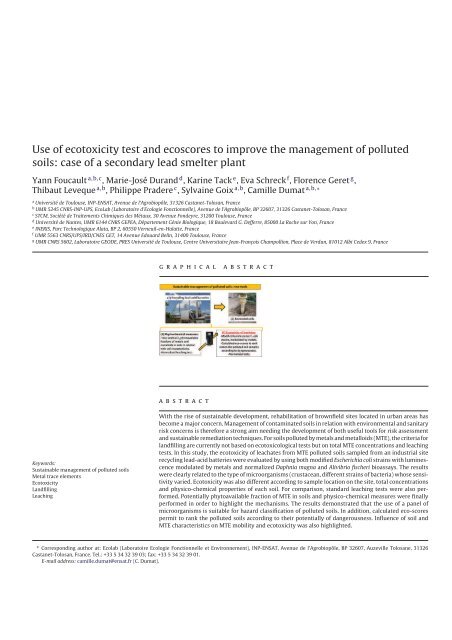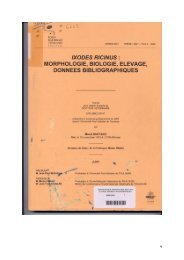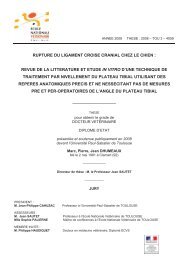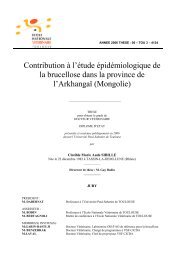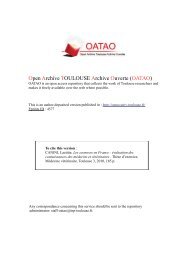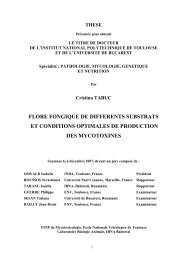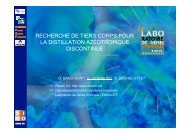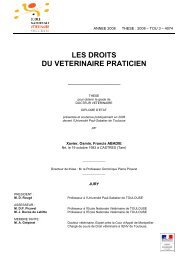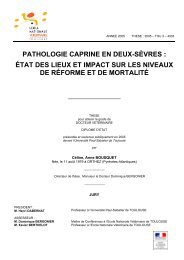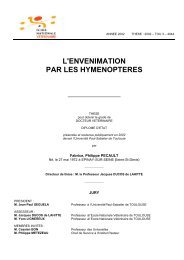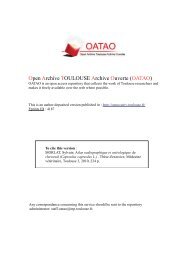PDF (Author's version) - OATAO (Open Archive Toulouse Archive ...
PDF (Author's version) - OATAO (Open Archive Toulouse Archive ...
PDF (Author's version) - OATAO (Open Archive Toulouse Archive ...
You also want an ePaper? Increase the reach of your titles
YUMPU automatically turns print PDFs into web optimized ePapers that Google loves.
Use of ecotoxicity test and ecoscores to improve the management of polluted<br />
soils: case of a secondary lead smelter plant<br />
Yann Foucault a,b,c , MarieJosé Durand d , Karine Tack e , Eva Schreck f , Florence Geret g ,<br />
Thibaut Leveque a,b , Philippe Pradere c , Sylvaine Goix a,b , Camille Dumat a,b,∗<br />
a Université de <strong>Toulouse</strong>, INPENSAT, Avenue de l’Agrobiopôle, 31326 CastanetTolosan, France<br />
b UMR 5245 CNRSINPUPS, EcoLab (Laboratoire d’Ecologie Fonctionnelle), Avenue de l’Agrobiopôle, BP 32607, 31326 CastanetTolosan, France<br />
c STCM, Société de Traitements Chimiques des Métaux, 30 Avenue Fondeyre, 31200 <strong>Toulouse</strong>, France<br />
d Université de Nantes, UMR 6144 CNRS GEPEA, Département Génie Biologique, 18 Boulevard G. Defferre, 85000 La Roche sur Yon, France<br />
e INERIS, Parc Technologique Alata, BP 2, 60550 VerneuilenHalatte, France<br />
f UMR 5563 CNRS/UPS/IRD/CNES GET, 14 Avenue Edouard Belin, 31400 <strong>Toulouse</strong>, France<br />
g UMR CNRS 5602, Laboratoire GEODE, PRES Université de <strong>Toulouse</strong>, Centre Universitaire JeanFranç ois Champollion, Place de Verdun, 81012 Albi Cedex 9, France<br />
g r a p h i c a l a b s t r a c t<br />
a b s t r a c t<br />
Keywords:<br />
Sustainable management of polluted soils<br />
Metal trace elements<br />
Ecotoxicity<br />
Landfilling<br />
Leaching<br />
With the rise of sustainable development, rehabilitation of brownfield sites located in urban areas has<br />
become a major concern. Management of contaminated soils in relation with environmental and sanitary<br />
risk concerns is therefore a strong aim needing the development of both useful tools for risk assessment<br />
and sustainable remediation techniques. For soils polluted by metals and metalloids (MTE), the criteria for<br />
landfilling are currently not based on ecotoxicological tests but on total MTE concentrations and leaching<br />
tests. In this study, the ecotoxicity of leachates from MTE polluted soils sampled from an industrial site<br />
recycling leadacid batteries were evaluated by using both modified Escherichia coli strains with luminescence<br />
modulated by metals and normalized Daphnia magna and Alivibrio fischeri bioassays. The results<br />
were clearly related to the type of microorganisms (crustacean, different strains of bacteria) whose sensitivity<br />
varied. Ecotoxicity was also different according to sample location on the site, total concentrations<br />
and physicochemical properties of each soil. For comparison, standard leaching tests were also performed.<br />
Potentially phytoavailable fraction of MTE in soils and physicochemical measures were finally<br />
performed in order to highlight the mechanisms. The results demonstrated that the use of a panel of<br />
microorganisms is suitable for hazard classification of polluted soils. In addition, calculated ecoscores<br />
permit to rank the polluted soils according to their potentially of dangerousness. Influence of soil and<br />
MTE characteristics on MTE mobility and ecotoxicity was also highlighted.<br />
∗ Corresponding author at: Ecolab (Laboratoire Ecologie Fonctionnelle et Environnement), INPENSAT, Avenue de l’Agrobiopôle, BP 32607, Auzeville Tolosane, 31326<br />
CastanetTolosan, France. Tel.: +33 5 34 32 39 03; fax: +33 5 34 32 39 01.<br />
Email address: camille.dumat@ensat.fr (C. Dumat).


